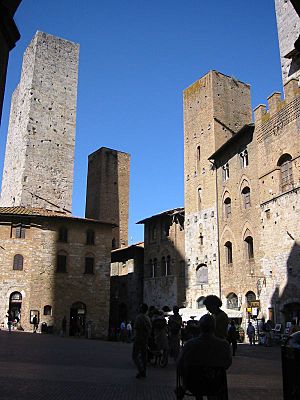Medieval commune facts for kids

During the medieval period in western Europe, especially from the 11th century onwards, people living in towns needed protection. There were often nobles (powerful lords) and bandits who caused trouble outside the city walls. Imagine leaving your safe, walled town and being at risk from anyone. Because there wasn't a strong central government or a police force like we have today, each town had to find ways to protect its own citizens. This led to the creation of groups called communes.
Communes were special agreements where people in a town promised to help and defend each other. When a commune was formed, everyone involved would gather and make a public promise, or "swear an oath," to stand together in times of trouble. They also promised to keep the peace within their city.
Contents
What Were Medieval Communes?
A commune was like a club for mutual protection. Members swore an oath to defend each other. This meant if someone from the commune was attacked outside the city, the commune would act to make sure the attacker faced consequences. This idea of consequences was meant to stop others from attacking commune members in the first place. For example, if a powerful noble attacked a townsperson, the commune might not be able to attack the noble's castle. Instead, they might target the noble's family, burn their crops, or destroy their orchards. This was a way of showing that attacking a commune member would lead to serious problems for the attacker.
Where Did Communes Start and Spread?
The idea of communes first appeared in the 11th century. It began in northern Italy, which had many cities and towns at that time. It also started in what is now Belgium, another area with many towns. In the early 12th century, the commune movement spread to France, Germany, and Spain.
England didn't have many communes. This was because England had a stronger central government and a more organized kingdom. People there didn't feel the same need to form local protection groups. While most communes were in cities, some were also formed in rural areas, especially in France and England. These rural communes helped villagers protect their shared interests.
How Did Kings and the Church See Communes?
Both the Church and the King had mixed feelings about communes. On one hand, they agreed that keeping people safe from lawless nobles was a good thing. Communes aimed to create peace by making attackers think twice. The Church, for example, also had its own ways to promote peace, like the Peace and Truce of God movement.
On the other hand, communes sometimes upset the traditional order of medieval society. The methods communes used, like seeking consequences for attackers, were not always approved by the Church or the King. In medieval times, fighting was usually seen as the job of noble lords. Townspeople, like merchants and workers, were not expected to be fighters. Communes blurred this line between "those who work" and "those who fight."
Because of this, communes were sometimes accepted and sometimes opposed by rulers and the Church. A famous example of a commune being put down, which then led to a town revolt, happened in the French town of Laon in 1112.
See also
 In Spanish: Comuna medieval para niños
In Spanish: Comuna medieval para niños

